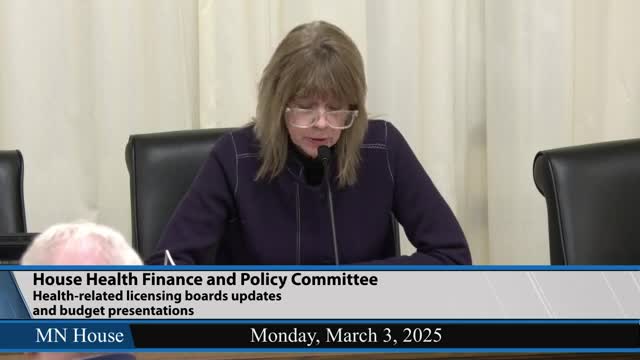Minnesota Board of Nursing reports increase in RNs and APRNs amid LPN decline
March 03, 2025 | 2025 Legislature MN, Minnesota
Thanks to Scribe from Workplace AI , all articles about Minnesota are free for you to enjoy throughout 2025!

This article was created by AI using a video recording of the meeting. It summarizes the key points discussed, but for full details and context, please refer to the video of the full meeting. Link to Full Meeting
The session began with a report on the current registration statistics for nurses in Minnesota. As of now, there are 134,648 registered nurses (RNs), 13,107 advanced practice registered nurses (APRNs), and 17,807 licensed practical nurses (LPNs). Notably, the number of RNs and APRNs is on the rise, while the LPN numbers have seen a decline.
The committee addressed the process for temporary permits for applicants seeking to practice in Minnesota while their applications are under review. If applicants meet the necessary requirements, they can receive a temporary permit valid for 60 days or until their license is granted.
A significant topic of discussion was the National Licensure Compact Act, which allows for mutual recognition of nursing licenses across participating states. Currently, Minnesota is not part of this compact, but the board of nursing is prepared to operationalize it if it becomes a directive.
The committee also reviewed compliance and discipline within the nursing profession. Since January 2024, the board has been averaging 150 complaints per month. To enhance the handling of these complaints, new positions have been added, including two nurse practice specialists, a paralegal, and a legal analyst. The board has implemented educational initiatives for its members and staff to improve the discipline process and has increased the frequency of monthly conferences to facilitate case management.
In terms of nursing education, the board oversees 89 pre-licensure nursing programs in Minnesota, which include various levels of training from practical nursing to advanced practice nursing. All programs are required to be accredited by a national nursing accrediting body. In 2024, there were 4,248 graduates from practical and professional nursing programs and 4,158 APRN graduates. However, trends indicate a 21.5% decrease in associate degree nursing program completions and a 34.8% decrease in practical nursing program completions compared to 2019. Conversely, completions for baccalaureate and entry-level master's programs increased by 28%, and APRN graduates rose by 17% from 2020 to 2024.
The meeting concluded with a call for written testimonies from presenters to ensure a comprehensive record for committee members. Representative Bonner initiated a question regarding the statistics presented, seeking clarification on the number of licensed nurses in the state.
Overall, the meeting underscored the evolving landscape of nursing in Minnesota, with a focus on workforce trends, regulatory compliance, and educational standards. The committee's discussions will likely inform future legislative actions aimed at addressing the challenges and opportunities within the nursing profession.
Converted from House Health Finance and Policy Committee 3/3/25 meeting on March 03, 2025
Link to Full Meeting
Comments
View full meeting
This article is based on a recent meeting—watch the full video and explore the complete transcript for deeper insights into the discussion.
View full meeting